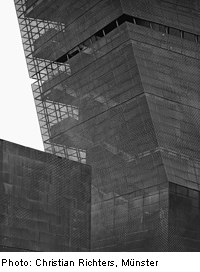The Modern Museum: Formally staged or with Classical Rigour?

Like a silvery, gleaming UFO, the new Mercedes-Benz Museum has landed in the suburbs of Stuttgart, joining the ranks of a host of spectacular buildings for the arts that have been created in recent times. The museum as an institution has long progressed beyond the status of a noble cultural temple, however, and has become a stage for events and experiences. In scarcely any other building type do designers enjoy such formal latitude and relaxed cost constraints.
Frank O. Gehry’s Guggenheim Museum in Bilbao can still be seen as the prototype of an extravagant and prodigally expensive form. With the sensational gesture it makes, though, it has become a catalyst for an entire region. At the same time, it kindles a discussion. Should museum architecture thrust itself into the limelight in this way, or should it serve as an unobtrusive container for the objects displayed within it? The two buildings presented at greater length in the present issue provide contrary answers to this question. The Mercedes museum mentioned above, designed by Ben van Berkel and UN Studio, adopts an extreme position. As a computer-generated mise en scène, it seems destined to become a landmark. In collaboration with the exhibition designers, the architects have succeeded in creating a dynamic spatial phenomenon with a wide range of sightlines, relationships and shifting perspectives. Staged with what might truly be called theatrical effect, the building perfectly fulfils its purpose as a vehicle and company museum.
A completely different approach can be seen in the Museum of Modern Literature by David Chipperfield in Marbach (geographically not far away from the Mercedes building). Quite unostentatiously and without strident gestures, it accommodates itself to the hilly topography, forgoing all superfluous attractions. Its minimalist expression and the few but good-quality materials that are used make the building a true treasury for sensitive manuscripts. With its classical rigour, the building is in harmony with the location (Schiller’s birthplace) and with its role as a museum of literature. Both museums described here reveal a model approach to their respective themes and their special locations. The question, therefore, should not be: “What is the modern form for a museum?”, but rather: “What is the appropriate response to the brief?”
